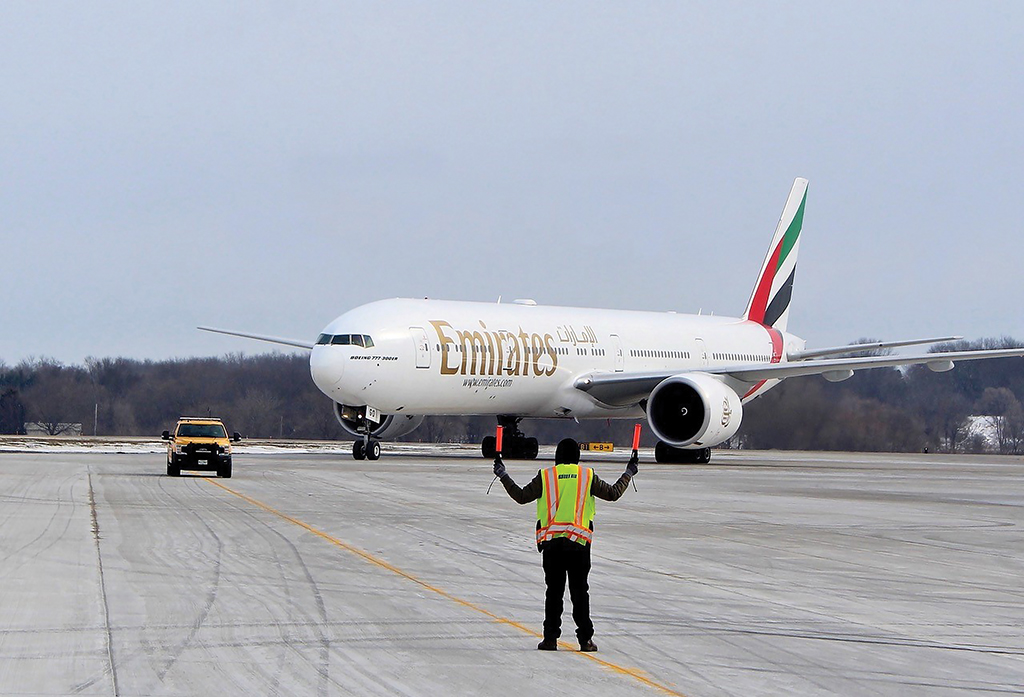
Chicago Rockford International Airport was the 14th busiest cargo airport in the US in 2021.
A passenger wanting to fly out of Chicago Rockford International Airport (RFD) can only choose from among the six warm-weather domestic destinations to which ultra-LCC Allegiant Air, the lone passenger carrier serving the Illinois airport, operates. Yet, an Emirates Boeing 777 can regularly be seen landing at the airport, located about 70 miles from Chicago.
Emirates SkyCargo, which started 777 freighter flights to RFD last year, is among a growing cohort of major cargo players utilizing well-positioned secondary airports to avoid intense congestion at major hubs.
Menzies Aviation, a ground handler serving more than 250 airports globally, began a 10-year lease with RFD on June 1 under which it is occupying a 50,000-sq.-ft. airport facility to provide cargo handling for both scheduled and chartered international freighter flights.
United Parcel Service (UPS) has operated a domestic hub at RFD since 1993. But the airport was, until recent years, largely viewed as a domestic-centric cargo facility handling traffic as part of UPS’s national delivery network. The arrival of Emirates, Menzies and other international operators signals RFD is now seen outside the US as a viable alternative to Chicago O’Hare International Airport (ORD) for cargo coming to the American midwest.

In addition to Emirates, Menzies and UPS, other cargo operators now using the airport include Amazon, Atlas Air, ABX Air, Korean Air, DB Schenker, National Airlines and Senator International (recently acquired by Maersk and being rebranded to the Maersk name).
According to FAA, RFD, which has two full-length runways, was the 14th busiest cargo airport in the US in 2021, handling nearly 3.5 billion pounds of landed weight, up 23% over 2020.
“We have added 360,000 sq. ft. of cargo warehousing over the last four years” in an effort to keep pace with demand, Zack Oakley, the executive director designate at RFD told ATW. Oakley is currently RFD’s deputy director of operations and planning and will assume the airport’s top management spot from Jan. 1, following executive director Mike Dunn’s planned retirement.
Oakley said the pandemic surge in air cargo traffic exacerbated long-standing congestion issues at big hubs such as ORD, driving freight forwarders and cargo operators to seek alternatives. That led to increasing numbers of freighter flights at airports such as RFD.
“The Chicago market in general is the largest cargo market by value in the US,” he explained. “We’re not congested as O’Hare is. So, while you may think, ‘If I have to send freight up to Rockford, it’s going to take an hour to get it to Chicago.’ Well, it’s going to take an hour, if not more, to get the freight in and out around O’Hare. … We’re developing our own service capabilities here in Rockford that allow us to do everything.”
When announcing the 10-year RFD cargo handling lease, Menzies executive VP-cargo Robert Fordree said the “the importance of secondary airports like RFD was highlighted during the pandemic” and predicted the trend would accelerate even as COVID-19 receded.
“Despite the current, cyclical downturn in cargo volume, we see secondary airports becoming more attractive due to less congestion, lower costs and great surrounding infrastructure, which will expedite goods getting from airport to final destination,” he said.
Prime Spot
RDF’s location is critical. Three major highways—US 20, I-90, and I-39—are easily accessible from the airport.
“From a cargo standpoint, our location is great because, when you think about it, there’s a ton of airports throughout the country that have nice long runways and may have land available, but that doesn’t mean they’re the right airport for cargo,” Oakley said. “The easiest part of moving cargo is going to be landing the aircraft, and that’s where everything begins—unloading of the aircraft and the processing of cargo.”
Brandon Fried, executive director at the Airforwarders Association, told ATW that getting freight trucks into and out of major passenger hubs can be a challenge for cargo operators. Trucks with trailers as long as 53 ft. need to “navigate the labyrinth of roadways in these airports” designed when trucks were smaller, he said.
Other factors complicate moving cargo to and from major airports, Fried noted, including big hubs’ aging freight infrastructure, slower aircraft processing time as freighters and passenger aircraft share runways and taxiways, higher landing fees, and trucks competing with automobiles on crowded airport landside roadways.
He said when forwarders have a choice, they are “probably not going to send cargo into the major airport.” Circumstances, such as cargo moving in the bellies of passenger aircraft, will often necessitate using a large airport, he explained, but forwarders increasingly would rather avoid the big hubs.
Transferring cargo between aircraft and trucks at large hubs can be time-consuming, Fried said.
“If you’re faced with having to wait 8-10 hours during the pandemic, or even 2-3 hours now, you’re going to put your trucks 65 miles west and they’ll recover cargo from an airplane that just came in and was unloaded immediately. And now you’re ready to serve the Chicago area,” he said.
Air cargo’s continuing reliance on paper documents and the industry’s slowness to digitize record transfers, a long-standing complaint of the Airforwarders Association, also causes forwarders to avoid larger airports, Fried said.
“It certainly doesn’t help when the driver of a 53-ft.-long tractor-trailer pulls up in front of an airline facility and he can’t communicate to determine whether or not his freight is on the ground and is available for pickup,” he said. “What happens is the 53-footer that is behind him now has to wait for [the first truck] to clear the area so that [the second truck] could drop his cargo off. It’s got this chain reaction.”
Still, O’Hare handled around five times more cargo than Rockford in 2021 and that discrepancy is not expected to significantly change. Oakley said RFD’s smaller operation means carriers can take advantage of efficiencies not available at a bigger hub airport, especially since RFD’s passenger footprint is so light.
Cargo traffic “growth can happen at Rockford and we’re still going to see that same efficient operation,” he explained. “We’re not going to become O’Hare anytime soon. So those efficiencies are going to exist for a while.”
